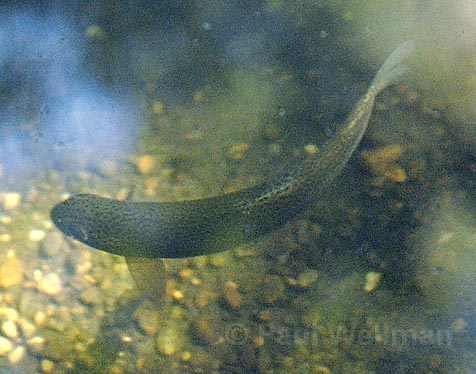Recovery Plan Envisions 4,150 Steelhead in S.Y. River
Hitchhiking back from Extinction

A federal plan to bring Southern California’s once-thriving steelhead population back from the brink of extinction has established the goal of having 4,150 adult steelhead running up and down the Santa Ynez River. That remains a far cry from the annual runs of 20,000 fish that made the Santa Ynez River a statewide Mecca for sport fishermen prior to the construction of Bradbury Dam-and Lake Cachuma-in the 1950s. Back then, the Santa Ynez was so bountiful that schoolkids were allowed to skip class when fishing season started, and farmers were known to use pitchforks rather than fishing poles to extract steelhead from the water. However historically diminished, the goal of 4,150 adult steelhead in the river seems staggeringly ambitious given the paltry populations that have managed to persist in the Santa Ynez and other rivers throughout Southern California. According to most estimates, regional steelhead populations have declined to less than one percent of what they were 50 years ago, despite considerable efforts during the past 15 years to rejuvenate the population.
The 4,150-fish figure was listed in a draft report authored by the National Marine Fisheries Service, the federal agency charged with restoring the steelhead, a species declared endangered 10 years ago. The number reflects the size of the steelhead population that needs to be found in the major rivers from Santa Maria to the Mexican border before the fish can be declared biologically viable-hence, eligible for de-listing. The report itself is a draft document, and designed to provide an outline of the efforts to be undertaken pending the formal completion of a full-fledged steelhead restoration plan. (That final plan was scheduled to be released earlier this fall, but is behind schedule.)
The report is eliciting dramatically different reactions from steelhead advocates and water agency officials. Environmentalists like the Environmental Defense Center’s Brian Trautwein have hailed the report as sound science, praising its central finding that the fish-which migrate to the ocean before returning to spawn in the river-must be reconnected with the fertile spawning grounds above Bradbury Dam for any restoration effort to succeed. Practically speaking, that means either trapping and trucking the fish above and below the dam or building fish ladders that might allow the fish to climb the face of the dam itself. Given the steepness of Bradbury, most fish enthusiasts regard trapping and trucking as the more likely alternative. “For the last 15 years, water agencies have been releasing just enough water below the dam to keep the steelhead just barely on life support and nothing more,” said Trautwein. “It’s time to stop taking water to where the fish are,” he said, “and start taking the fish to where the water is.”
Santa Barbara water agencies have responded to the federal report with guarded skepticism. “The report is just a draft,” said Tim Robinson, a biologist working with the Cachuma Operations Maintenance Board, the agency that manages the South Coast’s major source of drinking water. “I’m not sure where the 4,150 number comes from, how it was arrived at, or how reliable it is. It’s still too soon to say.” As for fish ladders or trapping and trucking the steelhead up the river, Robinson was equally noncommittal. “They’re certainly options. But they’re very expensive and very difficult options. We haven’t done the studies to determine how viable they are, and whether that’s the best use of our resources.” (Trautwein charged that water agencies have lobbied against such studies on the grounds that any form of fish transport along the Santa Ynez was intrinsically infeasible.) Robinson acknowledged, for example, that large-scale trapping and trucking operations take place in the Columbia and Snake rivers in the Pacific Northwest, but suggested the challenges along the Santa Ynez-which lacks easy access roads-might prohibit such operations. And he stressed that the water agencies had to balance the needs of the fish with the needs of their customers.
Robinson suggested that any fish transport program would prove costly. Trautwein-who acknowledged no reliable cost estimates exist-disagreed. “Given that the water from Bradbury Dam has driven all the agricultural, commercial, and residential development that’s taken place on the South Coast for the past 50 years, it’s a drop in the bucket,” he said. “It’s the least we can do.”



